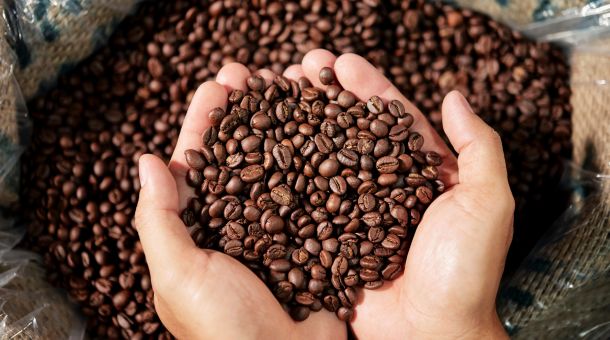Why Fresh Roasted Coffee Matters
Fresh roasted coffee matters for a multitude of reasons, transcending the realm of mere beverage preference.
The journey from bean to brew is a captivating one, where time, care, and precision play pivotal roles. In this article, we’ll explore the intricate dance of flavors and aromas that unfolds when coffee is freshly roasted, and how this pivotal moment impacts your daily cup of Joe.
Whether you’re a coffee aficionado or simply seeking the best way to elevate your morning ritual, understanding why fresh roasted coffee matters is essential for a truly delightful coffee experience.
Why Fresh Roasted Coffee Matters
3 Reasons Fresh Roasted Coffee is Better:
You’ve highlighted three compelling reasons why fresh roasted coffee is undeniably superior:
- More Vibrant Flavors: Freshly roasted coffee beans retain their natural oils and intricate flavor profiles, resulting in a cup of coffee that bursts with vibrancy and complexity. The nuances of each bean are preserved, allowing you to savor a spectrum of flavors that might be lost in older, staler beans.
- Taste the Notes We Put on the Bag: Coffee connoisseurs put painstaking effort into describing the unique tasting notes of their beans. When you choose freshly roasted coffee, you have the opportunity to genuinely experience the flavors and aromas that the experts have identified. This direct connection between what’s on the bag and what’s in your cup is a true testament to the art of coffee roasting.
- Peak Potential: Coffee, like any fresh produce, has a peak of potential flavor that gradually wanes with time. When you opt for fresh roasted coffee, you’re capturing it at its zenith. The aromas and taste are at their absolute best, ensuring that your coffee-drinking experience is consistently outstanding.
How long is fresh roasted coffee good for?

Fresh roasted coffee is at its best when enjoyed within a relatively short timeframe after roasting. In general, coffee beans are considered fresh and have the most vibrant flavor and aroma for approximately two to four weeks from the roasting date.
The freshness window can vary depending on factors such as the type of coffee beans (e.g., Arabica or Robusta), the roast level, and storage conditions.
To maximize the lifespan of fresh roasted coffee, it’s crucial to store the beans properly. Use an airtight container to protect them from exposure to oxygen, light, heat, and moisture, all of which can accelerate flavor degradation.
Additionally, if you purchase whole beans, grinding them just before brewing can help preserve the freshness.
Some coffee enthusiasts opt for vacuum-sealed packaging, which can extend the shelf life of coffee to a few months, while others may freeze their beans for longer-term storage. However, it’s essential to be mindful of proper storage practices to prevent moisture-related issues.
Although coffee remains safe to consume beyond the initial freshness window, the goal is to savor the rich and nuanced flavors that freshly roasted coffee offers.
To experience the full potential of your coffee, aim to enjoy it within the first month or two from the roasting date.
What are the health benefits of fresh roasted coffee

Fresh roasted coffee can offer several potential health benefits when consumed in moderation. Here are some of the key health benefits associated with fresh roasted coffee:
- Antioxidant Rich: Coffee is a significant source of antioxidants, which can help protect cells from damage caused by free radicals, potentially reducing the risk of certain chronic diseases.
- Improved Mental Alertness: The caffeine in coffee is a well-known stimulant that can enhance cognitive functions, including alertness, concentration, and mood, when consumed in moderate amounts.
- Reduced Risk of Some Diseases: Some studies suggest that coffee consumption may be associated with a lower risk of certain diseases, such as Parkinson’s disease, Alzheimer’s disease, type 2 diabetes, and certain types of cancer.
- Heart Health: Moderate coffee consumption may have a positive impact on heart health by reducing the risk of heart disease, stroke, and heart-related mortality.
- Liver Health: Coffee may support liver health by reducing the risk of liver diseases, including liver fibrosis, cirrhosis, and liver cancer.
- Physical Performance: Caffeine in coffee can enhance physical performance by increasing adrenaline levels, making it a popular choice among athletes for a pre-workout boost.
- Mood Enhancement: Coffee can improve mood and reduce the risk of depression, potentially due to its impact on neurotransmitters in the brain.
- Digestive Benefits: Coffee can stimulate bowel movements and may help alleviate constipation in some individuals.
What Colour is freshly roasted coffee?
Freshly roasted coffee beans can display a variety of colors depending on the roast level. The color of the beans evolves during the roasting process, and different roast levels produce different hues. Here’s a general overview of the color of freshly roasted coffee beans at different roast levels:
- Light Roast: Lightly roasted coffee beans are often light brown and may have a yellowish tint. They retain more of their original characteristics and often have a more pronounced shine due to the preservation of natural oils.
- Medium Roast: Medium-roasted beans are a medium brown color and have a balanced flavor profile. They might be slightly less shiny than light roasts but still exhibit a degree of glossiness.
- Medium-Dark Roast: At this stage, coffee beans take on a richer, darker brown color with hints of oil on the surface. The shine becomes more apparent as the beans reach a medium-dark roast.
- Dark Roast: Dark-roasted coffee beans are notably dark brown to almost black. They are oilier than beans roasted to lighter levels and have a glossy appearance. The oils released during roasting often migrate to the surface of the bean, giving them a distinct sheen.
- Espresso Roast or French Roast: These extremely dark roast levels result in nearly black, very oily beans. They have a shiny surface and an intense, smoky flavor.
What is the difference between raw coffee and roasted coffee?
| Aspect | Raw Coffee (Green Beans) | Roasted Coffee |
| Appearance | Green or pale yellow in color | Varies from light to dark brown, sometimes oily surface in darker roasts |
| Flavor and Aroma | Lacks the typical coffee aroma and flavor; tastes grassy or vegetal | Develops the characteristic coffee aroma and flavor with a wide range of notes like nutty, fruity, chocolaty, or floral, depending on roast level and bean variety |
| Shelf Life | Can be stored for a longer time, generally for many months to a few years | Best when consumed within weeks to a few months of roasting for optimal freshness |
| Caffeine Content | Contains caffeine but usually less than in roasted coffee | Roasting process can concentrate the caffeine content |
| Roasting Process | Requires roasting to develop flavor and aroma | Undergoes roasting at various levels to achieve the desired taste and characteristics |
| Cooking Process | Cannot be brewed directly; requires roasting before grinding and brewing | Ready for grinding and brewing into coffee beverages |
| Weight Loss during Roasting | Gains weight due to moisture loss | Loses weight due to moisture and some bean mass loss during roasting |
FAQ
How long does 1kg of coffee beans last?
Considering a daily consumption of just one single shot of coffee, a 1kg bag of coffee beans typically lasts approximately 4.5 months. However, if you prefer smaller quantities, a 250g bag might be a more suitable option for solo single-shot coffee drinkers.
How can you tell if coffee is high quality? How Can You Tell Good Coffee? –
Coffee School Good coffee will always have a rich, strong aroma and depending on the beans and roast, you might describe it as fruity, nutty, or floral. The flavour–or taste–will perfectly balance acidity, sweetness, and bitterness, with a notable and pleasant aftertaste.
What are the disadvantages of coffee roasting?
Coffee roasting has its drawbacks, with the most prominent concern being the potential inhalation of chemicals released during the process, such as diacetyl and acetyl propionyl. Inhaling these compounds can lead to a rare lung condition known as bronchiolitis obliterans, often referred to as “popcorn lung.”
What happens if coffee is over roasted?
When coffee is over-roasted, it can develop a bitter or burnt taste, which can often be mistakenly attributed to issues with your coffee preparation.
Conclusion
coffee roasting is an artful and intricate process that significantly impacts the flavor and quality of the final cup.
Understanding the intricacies of roasting, from the potential health concerns associated with inhaling certain compounds to the fine balance between achieving the perfect roast and avoiding over-roasting, is crucial for both coffee enthusiasts and professionals.
By being mindful of the roasting process and its potential disadvantages, we can continue to savor the diverse and rich world of coffee with a heightened appreciation for its nuances and complexities.
Why Fresh Roasted Coffee Matters Why Fresh Roasted Coffee Matters Why Fresh Roasted Coffee Matters
Why Fresh Roasted Coffee Matters Why Fresh Roasted Coffee Matters Why Fresh Roasted Coffee Matters Why Fresh Roasted Coffee Matters Why Fresh Roasted Coffee Matters Why Fresh Roasted Coffee Matters Why Fresh Roasted Coffee Matters Why Fresh Roasted Coffee Matters Why Fresh Roasted Coffee MattersWhy Fresh Roasted Coffee Matters Why Fresh Roasted Coffee Matters

